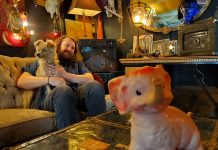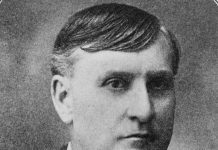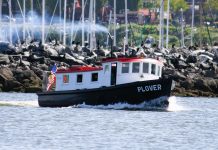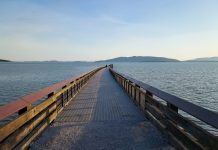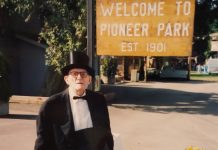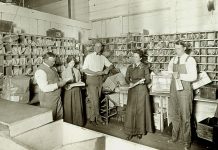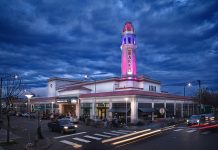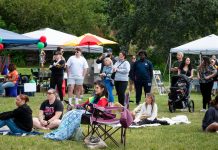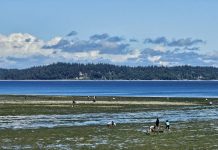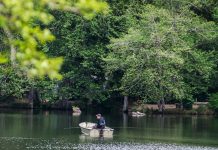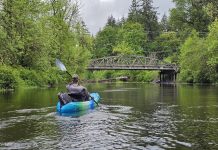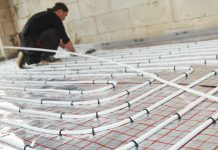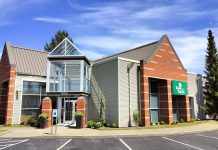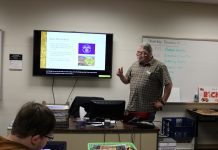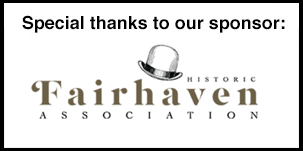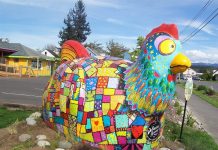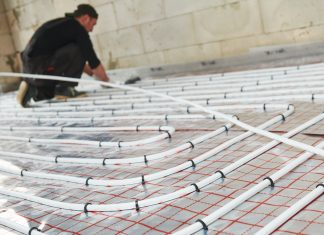In the heart of historic Fairhaven, visitors can discover four sculptures that commemorate iconic people from the town’s history. Three benches and a bust all stand near Fairhaven Village Green, a park completed alongside the first statue in 2003.
Fairhaven’s sculptures walk onlookers through the history of when Fairhaven, Bellingham, Whatcom, and Sehome were four separate towns. They encourage curiosity into the backstories of four influential characters who all made an impact in this charming enclave of Whatcom County: Dirty Dan Harris, Charles X. Larrabee, J.J. Donovan, and Mark Twain.
Dirty Dan Harris
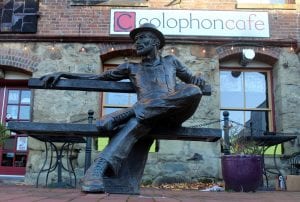
A statue at the Fairhaven Village Green commemorates Daniel Jefferson “Dirty Dan” Harris: Fairhaven’s founder and one of Bellingham’s most eccentric historical figures. Nicknamed for his crude manners and shabby dressing, Harris is remembered as a storyteller, smuggler, and drinker. He was born in Long Island, New York, sometime between 1826 and 1833, but sources differ on exactly where and when.
Harris arrived at Bellingham Bay in 1853 or 1854 and platted Fairhaven in 1883. He sold his land to Nelson Bennett and Charles X. Larrabee in 1889 and left for California. In the 1860s and ’70s, Harris invested in the Fraser River and Cariboo gold rushes. He built a road from Sehome to Lake Whatcom to transfer supplies to the Blue Canyon coal mine. Fairhaven remembers Harris through Harris Avenue and the Dirty Dan Harris Festival every April.
After promoting development of Fairhaven Village Green, local historian Brian Griffin proposed the Dirty Dan Harris bench that now stands there. Blaine sculptor Robert McDermott based the statue off written descriptions of Harris, pictured in only one known photograph. The sculpture depicts Harris sitting casually with his coat slung to the ground, befitting his gregarious character. It was dedicated at the Village Green’s 2003 opening.
Charles X. Larrabee
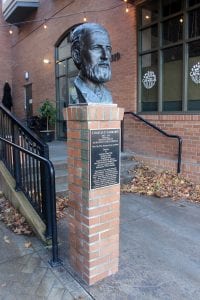
A bust on 11th Street commemorates Charles Xavier Larrabee, Fairhaven’s co-founder. He financed much of its growth through the Fairhaven Land Company after arriving in 1890. Larrabee had stakes in mining, ranching, railroading, real estate, and banking enterprises.
Since financing its 1890 construction, Larrabee and his family lived at the Fairhaven Hotel—a posh building demolished in 1955. Larrabee commissioned Seattle architect Carl Gould to design a mansion but died in 1914 before its construction. His widow Frances Larrabee supervised the completion of Larrabee Manor—now Lairmont Manor. In 1915, she donated land that would become Larrabee State Park.
The Charles X. Larrabee bust marks the entrance to McKenzie Alley. It is also the work of Robert McDermott and Brian Griffin. The plaque details the Larrabees’ donations and accomplishments on a brick pillar. Many of their descendants attended the October 15, 2008 dedication.
J.J. Donovan
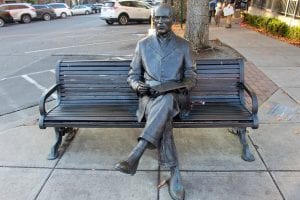
One prominent Fairhaven street corner commemorates John Joseph Donovan, another Fairhaven Land Company builder. Donovan arrived in 1888 at Nelson Bennett’s invitation to build a railroad through Fairhaven. While the Great Northern Railroad went to Tacoma instead, Donovan’s developments were instrumental in Fairhaven’s turn-of-the-century boom and consolidation.
Donovan helped develop the Fairhaven and Southern and Bellingham Bay and Eastern Railroads. He served on Fairhaven’s city councils and the Board of Trustees at Bellingham State Normal School (now Western Washington University). Among other philanthropy, Donovan funded construction of St. Joseph’s Hospital. Bloedel Donovan Park is named for him and business partner, Julius Bloedel, who donated former rail land in 1946.
The J.J. Donovan bench marks the intersection of 11th Street and Harris Avenue. It replicates a 1903 letter to his wife Clara, rediscovered in 2010 and featured in Whatcom Museum’s “Treasures from the Trunk” exhibition. Robert McDermott and Brian Griffin created the sculpture. The 2014 dedication featured speeches and live music.
Mark Twain
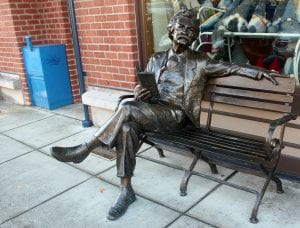
Fairhaven’s newest sculpture addition depicts its most famous visitor: Samuel Clemens, better known as Mark Twain. The renowned American writer and humorist is best known for The Adventures of Tom Sawyer and Adventures of Huckleberry Finn. Twain visited Fairhaven on August 14, 1895 during a worldwide lecture tour, aiming to overcome debt and gain inspiration.
Twain gave a lecture to 700 townspeople at New Whatcom’s Lighthouse Hall – now a Bank of America branch. He booked a bridal suite at Fairhaven Hotel. Twain visited the Cascade Club at the Mason Block (now Sycamore Square) for a cigar and drinks with prominent locals. The following day, he continued his financially and artistically successful tour in Vancouver, B.C.
The Mark Twain bench stands outside Village Books and Paper Dreams, holding a copy of Huckleberry Finn. World-famous Arizonan sculptor Gary Lee Price created it. Michael Botwin, Bellingham retiree and former California Deputy Attorney General, purchased and donated the sculpture. At its May 26, 2018 dedication, they described the statue’s relocation and Brian Griffin recounted the history of Twain’s Fairhaven visit. Locals now enjoy taking time to sit and read next to the great American novelist.
As this statue’s novelty shows, Fairhaven’s art scene is constantly changing. Yet more sculptures of local icons may one day stand where they stood in life.

